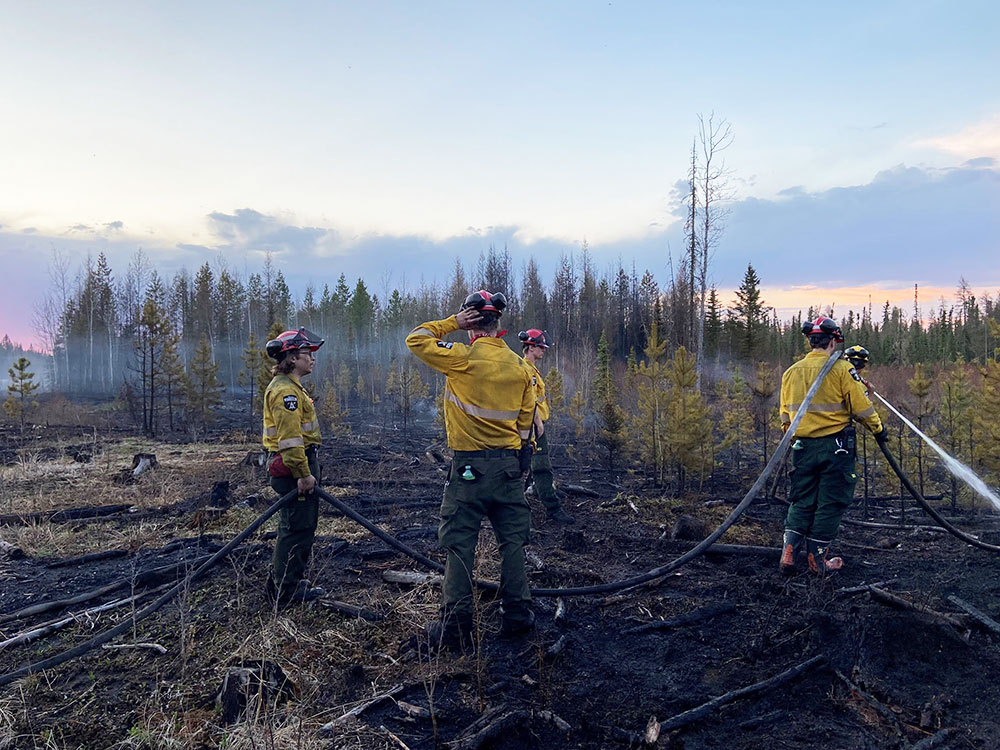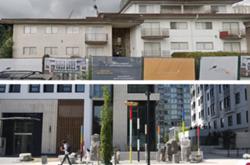This season of record-breaking wildfires in Alberta and across Canada makes clear the urgent need to develop integrated wildland fire and forest management plans to limit the destruction of priceless ecosystems. In pursuing this vital aim, Indigenous knowledge and modern science can work as complementary tools.
We take as an example the devastating fires that have affected Indigenous treaty right holders of northern Alberta, the Wood Buffalo National Park and the Wabasca wood buffalo herd. There is an opportunity to develop a regional plan that draws on the knowledge base of the local Indigenous knowledge keepers and the head start of a local Indigenous organization, the ShagowAskee foundation. The result might serve as a base and stimulus for thinking and the development of regional plans elsewhere in Canada.
Any such plan should start by assessing the total value of the ecosystem services. That is the value derived by people from those services, as opposed to not having them.
An ecosystem has physical, chemical and biological processes — such as wildlife habitat, carbon cycling and trapping of nutrients — that contribute to its self-maintenance. This system nurtures the animals and plants in food chains; provides food, medicines, building materials and housing; supplies clean water; protects cultural values and existence of the ecosystem; provides a global sink to absorb CO2; and generates income streams related to trapping, tourism, timber harvests and CO2 credits.
Some services provided by an ecosystem have a monetary value that is revealed in markets, for instance for food or timber. There are also ecoservices for which there is no market price, such as maintaining the forest and its biodiversity.
Yet other services provided by an ecosystem are perhaps quantifiable, but very hard to measure. They include the cost incurred by damage to the ecosystem and the value people placed on the lost ecoservices.
Sometimes, it is difficult to disentangle market value from the value of cultural or other ecoservices. For instance, trapping and hunting are traditional economic activities of Indigenous peoples of the North and are a treaty right. In the Wabasca wood buffalo herd area, however, the trails used by the buffalo were often also used by trappers and hunters and can perhaps best be viewed as having a value that is cultural, rather than economic. So there is a historic economic, cultural and legal connection between the buffalo and Indigenous people.
Although the concept of total economic value of an ecosystem has been around for decades, different analysts interpret its components differently, but most agree that it is composed of these components.
1. Current and future-use values. This refers to services which have monetary value. Non-use value refers to a broader category of value — including quiet enjoyment, and social and cultural aspects — for which there may be no monetary measure.
The fires in northern Alberta have caused an immediate economic loss of income and food resulting from disruption to hunting, fishing, trapping, as well as agriculture, forestry and tourism. Additionally, there are costs related to the destruction of houses and infrastructure, and, more importantly, the health costs for the local population. The significant health, economic and social costs for distant populations affected by smoke from these fires are an indirect loss of value.
Many potential future sources of economic value can also be destroyed by fire. By depriving the local population of traditional practices such as hunting, fishing and trapping in the longer run, a fire may indeed force those people to give up on supplying food for themselves and instead to rely on buying food at retail markets, which may be located some distance away. Indigenous people may also lose future revenue streams that draw on Indigenous knowledge associated with the protection of the local ecosystem, such as tourism revenues. Also lost is the value of sequestering CO2 through forests that are preserved.
2. Non-use or passive-use values. These include the emotional benefit derived from simply knowing a certain ecosystem good or service exists, including cultural continuity. Some people, including philanthropists, may be willing to pay for the preservation of the habitats where endangered species live, even though these habitats are in very remote areas.
The bequest value refers to the benefit derived from ensuring that the genetic uniqueness of plants and animals will be preserved for future generations. The bequest value is relevant for local populations and for future generations elsewhere. Devastating fires put these benefits at risk.
Where there are no available markets to value these ecoservices, other statistical methods, such as surveys of stated preferences and ranked ordering of preferences, may also be used. These depend heavily on whose preference is being expressed. Local Indigenous groups are likely to value local ecoservices more than distant populations, especially if the latter are paying for the services through taxation. Nonetheless, distant populations also benefit from reduced downwind smoke particulates. External investors may also see greater potential value in preserving or developing some intangible ecosystem services than the local population does.
When calculating the value of preserving Wood Buffalo National Park and the Wabasca wood buffalo herd, all these value elements need to be considered.
A well-suited plan would involve wildfire management while protecting biodiversity and cultural traditions and be the basis for creating future sources of sustainable income for Elders, knowledge keepers, trappers, gatherers, and other Indigenous way-of-life practitioners. The plan could also yield costs and benefits for remote groups.
We make five recommendations.
First, a leadership role should be granted to the groups in northern Alberta most affected by local fires. These Indigenous communities and Indigenous knowledge keepers have the most to gain from preserving the forest, biodiversity and their way of life. They also view the forest and the land somewhat differently than western society generally does. For example, they think that targeting wildfire mitigation/adaptation around forest communities, powerlines, railroads and highways is the place to start.
However, the ShagowAskee foundation and related groups can and do also draw on the best western national and international resources and research, enabling them to develop a plan that could serve as a model for all regions. Indeed, there may be a great opportunity to create an Indigenous Protected and Conserved Area, or IPCA, and/or an Indigenous Model Forest where many can learn from the learning-by-doing approach.
Second, although the problems of wildfire management in Canada have been apparent for many years, the 10-fold increase in fires in 2023 shouts out for greater public and private funding and for the implementation of the Canadian Wildland Fire Strategy of 2006. Optimal wildfire management will require greater Indigenous co-management as well as regional and local plans, led by local communities. These plans should focus on wildfire prevention and provide more financial support to the most vulnerable rural communities.
Third, the integrated wildland fire and forest management plans should aim to maximize the value stream of net benefits from all the ecosystem resources that are threatened by fire. This means not only managing wildfires but also protecting treaty rights and creating new revenue streams associated with the ecosystem. These could include sustainable forestry, rural tourism and credits for CO2 sequestration and biodiversity protection.
Fourth, the plan should recognize the rising future use value of ecosystem resources. This is an invitation to develop commercial (e.g. carbon and biodiversity offset) projects which protect treaty rights, along with infrastructure projects to support fire management. These projects could help to preserve the forest and biodiversity while also generating income and creating jobs.
Increased insurance coverage and different types of insurance for community fire risk may well be needed to attract potential investors in carbon credits. The integrated wildland fire and forest management plan should be designed to reduce those risks and could, in part, be financed by insurance premiums.
Fifth, a suitable plan requires comparing the expected benefits of that plan to alternative plans. The comparisons can reflect the uncertainty of future cost and revenue streams, as well as user perceptions of non-use value.
The optimal plan would maximize the value stream of net benefits both from the perspective of the local population and from those indirectly affected by the plan.
The challenge is not whether to preserve the forest and the biodiversity, but how to do so in a way that maximizes the present value stream of net benefits from the ecosystem resources. With a better understanding of ecosystem services and value, it will be easier to then mobilize public support for a policy environment that attracts private investment to tap ecosystem service opportunities. Potential investors in sustainable activities will be attracted only if there is evidence that governments are committed to protecting the forests, preserving biodiversity and respecting treaty rights.
Environmental management is not only central to preserving what is priceless but is also the basis for developing new business opportunities that will pay their own way and supplement the future need for greater government support.
It is time for the governments of Alberta and Canada to collaborate with Indigenous communities. Together, they can prevent the destruction of priceless assets and build a future that respects treaty rights, creates sustainable businesses and preserves the Wood Buffalo National Park and the Wabasca wood buffalo herd.
The authors were contracted by the ShagowAskee foundation to prepare this article. ![]()
Read more: Indigenous, Alberta, Environment
















Tyee Commenting Guidelines
Comments that violate guidelines risk being deleted, and violations may result in a temporary or permanent user ban. Maintain the spirit of good conversation to stay in the discussion and be patient with moderators. Comments are reviewed regularly but not in real time.
Do:
Do not: